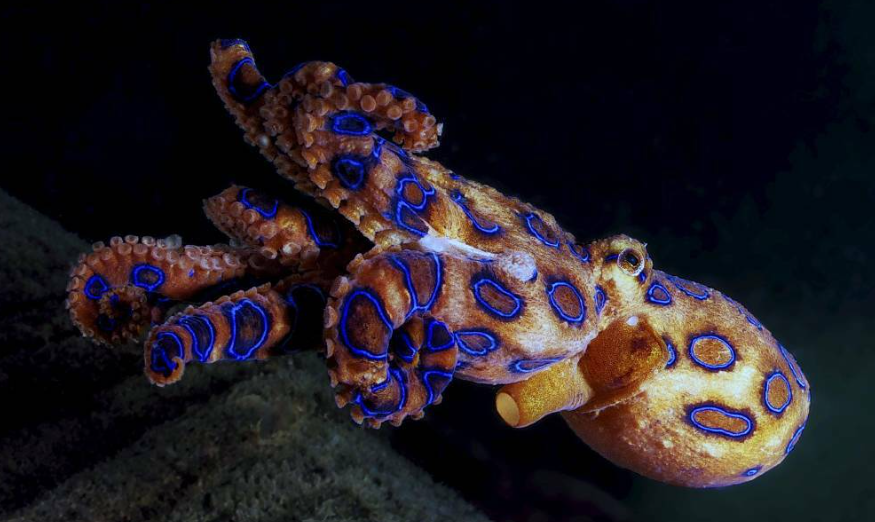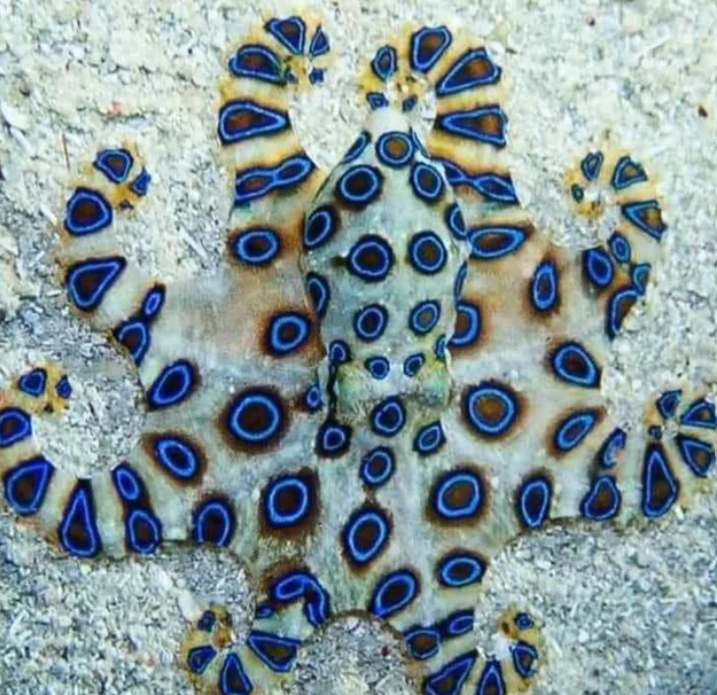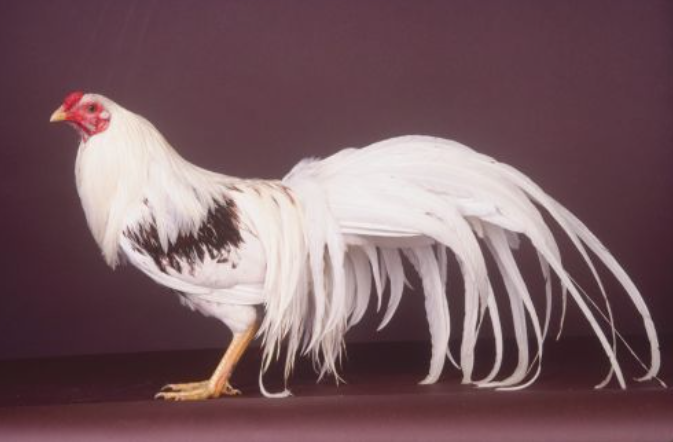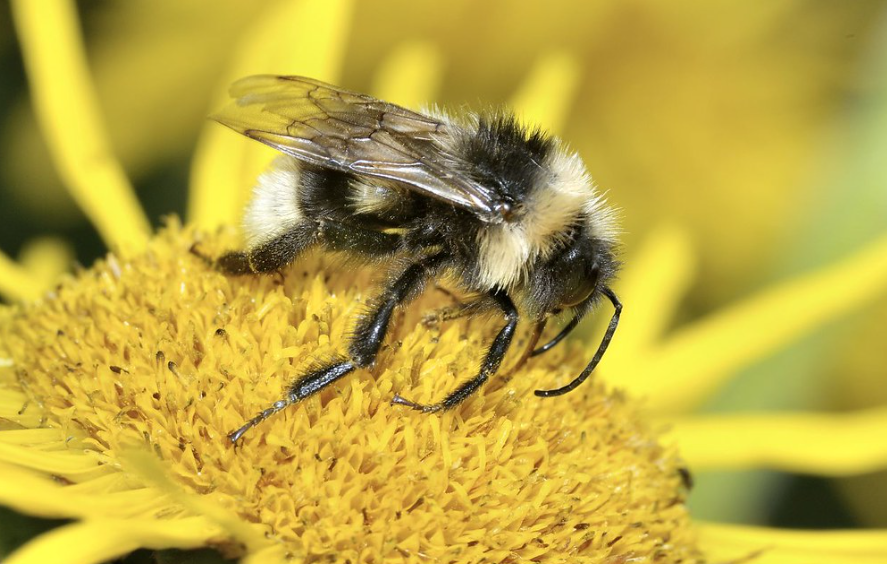
Quick Top 10 Facts about Blue-Ringed Octopus
| SCIENTIFIC NAME | Hapalochlaena (Genus of Blue-Ringed Octopuses) |
| CLASSIFICATION |
KINGDOM: Animalia PHYLUM: Mollusca CLASS: Cephalopoda ORDER: Octopoda FAMILY: Octopodidae GENUS: Hapalochlaena |
| SIZE | Typically 8 to 10 inches (20 to 25 cm) in body length |
| HABITAT | Coastal waters of the Pacific and Indian Oceans, particularly around Australia and Southeast Asia |
| DIET | Carnivorous, feeding on crustaceans, small fish, and mollusks |
| SPECIES | Four known species: Hapalochlaena lunulata, Hapalochlaena maculosa, Hapalochlaena nierstraszi, and Hapalochlaena fasciata |
| COUNTRY | Australia, Japan, Indonesia, and the Philippines |
| GESTATION PERIOD | Females lay eggs that hatch in a few weeks; females die after laying eggs |
| LIFE SPAN | 1 to 2 years |
| CONSERVATION STATUS | Not currently endangered, but the destruction of their habitats and their venomous nature makes them at risk of human harm |
Amazing Facts About Blue-Ringed Octopus
1. Known for their vibrant blue rings
When threatened, Blue-Ringed Octopuses display bright, neon-blue rings all over their body, which is a warning sign of their toxicity.
2. Extremely venomous
They possess one of the most potent venoms of any marine animal, capable of paralyzing and potentially killing a human with just one bite.
3. Venom causes paralysis
The venom from a Blue-Ringed Octopus contains tetrodotoxin, which can cause paralysis and even death in humans if left untreated.
4. Small size but deadly
Despite their small size (usually less than 10 inches in length), their venom makes them one of the most dangerous marine creatures.
5. Often found in rocky or coral reefs
Blue-Ringed Octopuses tend to hide in crevices or under rocks, making them difficult to spot until they feel threatened.
6. Not aggressive by nature
They are generally not aggressive and only bite when provoked or threatened, preferring to hide rather than attack.
7. Short lifespan
Blue-Ringed Octopuses have a relatively short lifespan of about 1 to 2 years, which is typical for many cephalopods.
8. They change color to blend in
When not agitated, Blue-Ringed Octopuses are a dull yellowish-brown and are often indistinguishable from their surroundings. They only display their blue rings when feeling threatened.
9. Highly intelligent
Like other octopuses, Blue-Ringed Octopuses are highly intelligent and capable of problem-solving and escaping from enclosures in aquariums.
10. Rarely encounter humans
Although they are dangerous, encounters with humans are rare because they inhabit relatively remote areas and tend to avoid human contact.
Potent venom produced by blue-ringed octopuses and its purpose in hunting and defence
The striking blue rings on the incredible Blue-Ringed Octopus stand out when the creature feels threatened or agitated. These rings serve as a signal to potential predators to keep away because of the octopus’s severe venom. This small mollusk lives in the oceans of the Pacific and Indian Oceans, particularly those around Australia and Indonesia.
neurotoxin called tetrodotoxin found in their saliva, which can cause paralysis and respiratory failure in their prey
Despite its small size, the Blue-Ringed Octopus contains one of the strongest venoms of all animals. Its venom contains tetrodotoxin, a neurotoxin that may be fatal and immobilise victims if untreated. The octopus injects its venom into its victims by biting them and injecting the poison into them.
Importance of understanding the facts about blue-ringed octopuses to ensure safety and conservation
The Blue-Ringed Octopus is an amazing animal with strong venom and vivid blue rings. Even though it is small, it is a dangerous predator and an interesting animal to research. But it’s crucial to keep in mind that this octopus can only be appreciated from a safe distance since its venom may be quite dangerous to people. We might have greater respect for the many and distinctive animals that live in our waters if we comprehend and value the Blue-Ringed Octopus.
The danger of their venom to humans and the importance of avoiding contact with or handling these creatures.
It fits in well with its surroundings to avoid being seen. Its body has a beige or light yellow hue, which makes it blend in well with the sand-coloured ocean floor. When the octopus senses danger or is hunting, it may suddenly change its hue to display its bright blue rings, alerting any bystanders. This ability to change colour is attributed to chromatophores, which are specialised cells that may expand or shrink to reveal different pigments. Blue-ringed octopuses are stunning creatures, but in the wild, you should approach them with caution since they may bite you pretty severely.

Fascinating facts about blue-ringed octopus
A remarkable animal found in the coastal seas of the Pacific and Indian Oceans is the blue-ringed octopus. This octopus is well-known for its strong venom and vivid blue rings, despite its small size.
Size and Appearance of the Blue-Ringed Octopus:
At about 5 to 8 inches in length on average, the Blue-Ringed Octopus is among the smallest octopus species. Its body is usually beige or light yellow, although it may change colour to match its environment. This octopus’s most remarkable characteristic is its brilliant blue rings, which show up when the creature feels threatened or disturbed.
Toxin of the Blue-Ringed Octopus:
The Blue-Ringed Octopus is one of the most poisonous marine animals, despite its small size. It yields tetrodotoxin, a neurotoxin 1,200 times more powerful than cyanide. This venom is harmful to people and has the ability to paralyse its target. If treatment is not received, bites from a blue-ringed octopus may result in respiratory failure, muscular paralysis, and even death.
Diet and Hunting of Blue-Ringed Octopus:
Being an expert hunter, the Blue-Ringed Octopus mostly consumes tiny crustaceans like prawns and crabs. It pierces the shells of its victims with its razor-sharp beak and injects venom to render them immobile. The octopus may devour its victim whenever it pleases once it has been paralysed. The Blue-Ringed Octopus, while poisonous, does not pose a danger to people unless provoked.
Defence Mechanisms and Behaviour of Blue-Ringed Octopus:
The Blue-Ringed Octopus has an amazing protection mechanism when it feels attacked. Its body colour will initially become deep brown or black, emphasising the blue bands on its body even more. In order to warn off any predators, it may also lift and stretch its arms wide, showcasing its vivid rings. In the event that these demonstrations are ineffective in dissuading the danger, the octopus will bite.

Reproduction of the Blue-Ringed Octopus:
The reproduction process of the blue-ringed octopus is distinct. The female will deposit a cluster of tiny eggs after mating, which she will subsequently adhere to a hard surface. She will watch over these eggs nonstop, making sure they get enough water and keeping predators away. During this time, the female will not eat, and after the eggs hatch, she will finally pass away. At birth, the hatchlings are fully developed and self-sufficient.
Dispersion and Environment of Blue-Ringed Octopus:
The Pacific and Indian Ocean’s coastal waters, which include places like Australia, Indonesia, Japan, and the Philippines, are home to the Blue-Ringed Octopus. It favours environments that are rocky, sandy, or shallow so that it may fit in with its surroundings and remain hidden. The Blue-Ringed Octopus is a highly adaptive species that can flourish in a range of settings, despite its tiny size.
FAQ (Frequently Asked Questions) about Blue-Ringed Octopus
Q: What is a Blue-Ringed Octopus?
Ans: The Blue-Ringed Octopus is a small but highly venomous species of octopus found in the Pacific and Indian Oceans. Its name comes from the brilliant blue rings that appear on its body when it is threatened or agitated. Despite its small size, it is one of the most dangerous marine animals due to the potency of its venom.
Q: Where do Blue-Ringed Octopuses live?
Ans: Blue-Ringed Octopuses are typically found in the warm waters of the Pacific and Indian Oceans. They are often spotted in tide pools, coral reefs, and shallow coastal waters, particularly around Australia, Japan, and the Philippines. They prefer rocky, sandy, or muddy habitats where they can hide in crevices or burrows.
Q: What do Blue-Ringed Octopuses eat?
Ans: Blue-Ringed Octopuses primarily feed on small crustaceans, mollusks, and fish. They use their sharp beak to break open the shells of their prey and inject venom to immobilize them before consuming them. They are skilled hunters and are able to ambush their prey with stealth and precision.
Q: How dangerous are Blue-Ringed Octopuses?
Ans: Blue-Ringed Octopuses are extremely dangerous due to the potent venom they carry. Their venom contains a neurotoxin called tetrodotoxin, which is powerful enough to cause paralysis and even death in humans. Bites are often painless, but the venom can rapidly affect the nervous system, leading to paralysis and respiratory failure. If bitten, it is important to seek immediate medical attention.
Q: How big do Blue-Ringed Octopuses get?
Ans: Blue-Ringed Octopuses are small, typically growing to around 8 to 10 inches (20 to 25 cm) in length when fully extended. Despite their small size, their bright blue rings are an unmistakable sign of their presence, and their size makes them agile hunters in their underwater environments.
Q: How do Blue-Ringed Octopuses communicate?
Ans: Blue-Ringed Octopuses primarily communicate through their skin, which can change color and display vibrant blue rings when they feel threatened or stressed. These rings serve as a warning signal to potential predators. Their color-changing ability is a result of specialized cells in their skin called chromatophores that contain pigments and can expand or contract to alter their appearance.
Q: Are Blue-Ringed Octopuses aggressive?
Ans: Blue-Ringed Octopuses are not generally aggressive unless they feel threatened. They are shy creatures and prefer to remain hidden in crevices or burrows. The blue rings that appear when they are agitated are a warning to predators and humans. They will only bite in self-defense, and their venom is used as a last resort to protect themselves.
Q: Can a Blue-Ringed Octopus be kept in an aquarium?
Ans: Due to their highly venomous nature and specialized care requirements, Blue-Ringed Octopuses are not recommended for home aquariums. They need a carefully controlled environment, as well as specific conditions to thrive. Only experienced aquarium keepers who can ensure their safety and the safety of others should consider keeping one in a controlled setting.
Q: How do Blue-Ringed Octopuses reproduce?
Ans: Blue-Ringed Octopuses reproduce sexually. Males use a specialized arm called a hectocotylus to transfer sperm to the female. After mating, the female lays eggs, which she guards until they hatch. Once the eggs hatch, the young octopuses are independent and are fully capable of hunting and surviving on their own. The lifespan of a Blue-Ringed Octopus is typically around 2 years.
Q: Are Blue-Ringed Octopuses endangered?
Ans: While Blue-Ringed Octopuses are not currently classified as endangered, their populations could be affected by habitat destruction, pollution, and climate change. However, they are not typically targeted by humans for hunting or trade, and they tend to avoid human interaction, which helps protect them in the wild.
#BlueRingedOctopus, #Octopus, #MarineLife, #VenomousAnimals, #DangerousAnimals, #MarineBiology, #UnderwaterCreatures, #TropicalOceans, #OceanLife, #CoralReef, #AquaticCreatures, #Invertebrates, #OceanConservation
Our sources and references about Blue-Ringed Octopus
1: Wikipedia – Blue-ringed Octopus
2: National Geographic – Blue-Ringed Octopus
3: Australian Geographic – Blue-Ringed Octopus Facts
4: Smithsonian Magazine – Blue-Ringed Octopus


